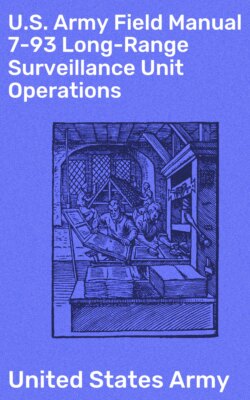Читать книгу U.S. Army Field Manual 7-93 Long-Range Surveillance Unit Operations - United States Army - Страница 7
1–2. HUMAN INTELLIGENCE CAPABILITIES
ОглавлениеLong-range surveillance units provide the corps with a dedicated company and the division with a dedicated detachment. These units are specially trained and equipped to collect human intelligence about forces deep in the enemy's rear. LRS units are part of the overall intelligence collection process. They augment and complement other collection systems that are more vulnerable to limitations such as weather, range, terrain masking, and enemy countermeasures. LRS units also allow corps and division commanders to gather timely information that does not need lengthy processing and analysis.
a. The employment ranges for the LRSU missions depend on METT-T, operational tempo, and support considerations. In a fast-paced battlefield environment, the depth of LRSU employment is greater because the area of interest is larger. Long-range surveillance detachment teams operate forward of battalion reconnaissance teams and cavalry scouts in the division area of interest. The long-range surveillance company teams operate forward of the LRSD teams and behind most special operations forces. (See Table 1–1.) The duration of an LRS mission depends on equipment and supplies the team must carry, movement distance to the objective area, and resupply availability. LRSU teams normally operate up to seven days without resupply depending on terrain and weather. Teams may be deployed longer in special cases. Operations other than war are likely to be nonlinear, with no identifiable forward line of own troops. Surveillance must extend in all directions. Deployment considerations are adjusted with the political and geographical effects included. The specific area of operations changes as additional maneuver units are sent into the area of operations.
b. LRS teams are organized, trained, and equipped to enter enemy areas to observe and report enemy dispositions, movements and activities, and battlefield conditions. The teams' missions, targets, and objectives are based on the intelligence requirements of the commander. Teams infiltrate selected areas by air, ground, water, or stay-behind. While avoiding contact with the enemy and local civilians, these teams observe. They may emplace a variety of unattended sensors and special-purpose equipment to detect, observe, and monitor enemy activities. They perform other specified collection tasks as well. LRS teams are not intended, and lack the capability, to conduct direct-action missions. Their mission of limited reconnaissance and stationary surveillance is different from the missions of most special forces and rangers.
c. Teams operating in the corps or division area of interest use highly developed infantry and ranger skills to infiltrate enemy-controlled areas, evade enemy rear-security operations, then exfiltrate with or without assistance. These infantry and ranger skills are needed for survival and to complete the mission. Teams also have expert information-collection skills, and they know enemy organizations, tactics, and equipment. They are also experts in using communication systems. These skills are attained through individual, institutional, and unit (collective) training programs. (See Appendix A for information on personnel recruitment and selection.)
